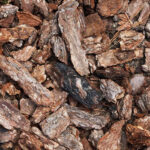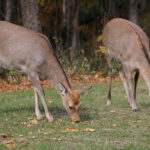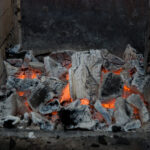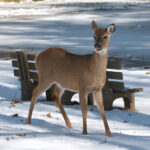We’ve all heard a pesky woodpecker drumming away on a nearby tree or telephone pole. In most cases, it’s just an auditory disturbance.
But what if a woodpecker is hammering away at your log home or cabin? Could they cause real damage?
This article will explain why your house is being targeted, successful deterrents, and how to repair any damage they may have caused,
Read on to learn 5 ways to keep Woodpeckers away from your log home for good!
This page contains affiliate links. As an Amazon Associate, I earn from qualifying purchases.
Table of Contents
- Why Woodpeckers Peck On Wood Houses
- How To Keep Woodpeckers Away From Log Homes
- Additional Woodpecker Deterrents and Methods
- What Smells Repel Woodpeckers?
- Are Woodpeckers Scared Of Reflective Things?
- Bird Netting And Spikes To Deter Woodpeckers
- Repair Woodpecker Damage
- Conclusion
- Related Posts
Why Woodpeckers Peck On Wood Houses
The biggest reason woodpeckers will peck on your log home is simply because they’re hungry. They eat a variety of insects including worms, ants, termites, carpenter bees, and other small bugs – many of which might have taken up residence in the logs of your house.
Unfortunately, food is not the only reason woodpeckers drum on houses.
Woodpeckers may also peck to communicate to other woodpeckers that the territory has been claimed. Pecking is also seen as a mating call to attract any interested females in the area.
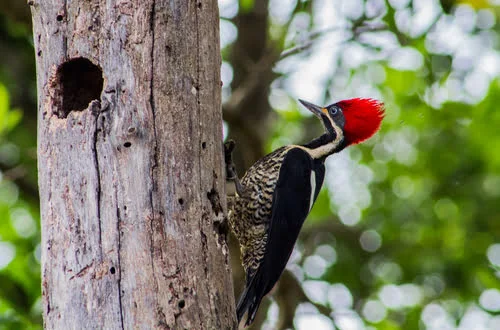
How To Keep Woodpeckers Away From Log Homes
Regardless of why a woodpecker has taken a liking to your house, below are some of the main deterrents you can use to defend your log home from these pesky birds.
Disclaimer: It is legal to kill a woodpecker in the U.S., so your best bet is to stick with one of the below methods rather than trying to take things into your own hands.
See Also: Woodpeckers And Your Home
Kill The Insects That Woodpeckers Feed On
Assuming that a woodpecker is targeting your log home because it’s hungry, the best way to deter them is by eliminating any bugs that they are trying to get out of the logs.
If you want to try the do-it-yourself method first, then focus on an insect treatment with a borate wood preservative like ArmorGuard, PeneTreat, or Shell-Guard RTU.
Borate is a compound made from oxygen and Boron. When ingested by insects, borate essentially disrupts the metabolic functions of insects and kills them slowly by starvation.
The wood preservative is applied to and then absorbed by the logs, creating a barrier that termites and other insects cannot cross.
Without a food source, most woodpeckers will give up and find someplace else to drum up their next meal, leaving you with blissful silence.
If you have tried borates or other insecticides without any success, you might need to contact a local exterminator to help with your pest problem.
Use Woodpecker Deterrents and Methods
There are several deterrents and methods that can be used for pesky woodpeckers. Motion-activated deterrents use motion sensing technology that is triggered when movement is detected. There are several options available.
Motion Activated Water Sprinklers
The first motion-activated deterrent option, and arguably the best one, is motion-activated water sprinklers. If a woodpecker decides to perch on your house, the sprinklers will be triggered and they’ll get a quick spray.
Since woodpeckers don’t like surprises, anything that catches them off guard should scare them off, automatically making this a good deterrent.
Aside from an increased water bill, the only downside to a motion-activated sprinkler is that it can only deter woodpeckers within the radius that it can spray.
This means you would need one for each side of your cabin… that’s a lot of sprinklers and water. Unfortunately, water and moisture are two of the worst things for a home made out of logs.
This may lead you to the second option, a motion-activated alarm.
Motion Activated Alarm
Motion-activated woodpecker alarms can be ultrasonic so humans can’t hear them or trigger loud alarms when motion is detected in targeted areas.
Birds, in general, are very skittish and don’t like loud noises, so they fly off the second the alarm goes off.
Woodpeckers have been known not to avoid areas where they have previously detected ultrasonic sound waves. Alarms are a good deterrent if you have a pesky pecker that keeps returning to your house after using other deterrents.
You can find several types of quality motion-activated alarms with lights as well, on Amazon.
Additional Woodpecker Deterrents and Methods
Scare Dummies
Small birds are afraid of large predators and will avoid areas that pose a threat. Use this knowledge to your advantage by placing scarecrow dummies on the roof of your cabin.
Scare balloons are a great deterrent. Pick up a few snake, hawk, and falcon balloons. If you can find ones that have the mouth open that’s even better as it will look to the woodpecker like an imminent threat.
The two downsides of using scare balloons are that they will need to be replaced more frequently than some other deterrents, and they can be unsightly.
They are best used by people who don’t have neighbors nearby to complain about yard aesthetics.
Fake Owls
Owls prey on woodpeckers, so using owl decoys as a deterrent is usually fairly effective. Other predator-based deterrents have been shown to work as well.
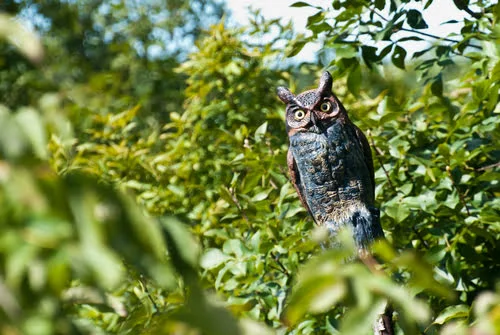
What Smells Repel Woodpeckers?
If insects don’t seem to be the problem and you don’t want to spend a lot on commercial deterrents, then making a homemade, natural repellant might be the trick.
There are a few smells that woodpeckers dislike – vinegar, garlic, and peppermint. Two popular choices for woodpecker repellent are mixtures of peppermint essential oils infused with garlic or vinegar mixed with water and dried red or green chili peppers crushed and added to the solution.
While neither of these mixtures is recommended to spray directly onto the logs of your home, you can easily spray the perimeter of your house, to deter woodpeckers from roosting and pecking.
Another option is to hide mothballs in the bushes or brush near your house. Like other animals, woodpeckers are not a fan of the pungent scent emitted by mothballs and will likely give your property a second thought.
One thing to consider before using a scented deterrent is that you’re going to have to tolerate the smell yourself.
If minty garlic and mothballs are your jam, then have at it! If not, then you might want to consider some other options.
Hang the deterrents from trees where you can as any movement caused by wind will add to the scare factor.
Are Woodpeckers Scared Of Reflective Things?
Woodpeckers are not only afraid of shiny things that reflect light, but also of other birds. Even if the “other bird” is actually the woodpecker. If it thinks there is another bird in the area, then it won’t perch on your house.
To deter woodpeckers, hang things in trees that are reflective. Small mirrors, aluminum pie pans, reflective tape, and reflective wind chimes are all viable options.
Again, yard aesthetics come into play here so only choose this option if you live in a secluded place.
Reflective wind chimes and tape are both a bonus as they make unexpected noises that will also scare woodpeckers.
Bird Netting And Spikes To Deter Woodpeckers
While these options should be used as a last resort, they have been proven to be effective.
Bird netting is ideal to keep woodpeckers from perching on your roof, but it can also be attached to the side of your home to protect logs from damaging pecking.
Bird netting can be dangerous to all birds though as it can trap the birds and prevent them from hunting for food. If you opt for bird netting, it is recommended that you have someone with bird netting experience help you install it at your house.
Remember the goal is to deter woodpeckers, not to harm or kill them!

Bird spikes are best for use on your roof. If a woodpecker has been using your roof to send mating calls, then you might want to consider adding a row or two of bird spikes to the roof of your dwelling.
While very ominous-looking, bird spikes are actually rather harmless. If a woodpecker tries to land on them, they will simply get a small prick on their feet and fly off – no permanent harm done.
Unfortunately, bird spikes can be a little unsightly and are definitely not safe to attach to the side of your log home. Save them for roof use only, your neighbors will thank you.
Repair Woodpecker Damage
It’s a regrettable truth that most people discover they have a woodpecker problem after at least a little damage has been done to their house.
If you’re in this camp, don’t worry. Woodpecker damage is actually pretty easy to repair.
All you need is a replacement wood putty epoxy that you can find at most home-improvement stores. Just mix up the epoxy and place it in the woodpecker holes, then smooth over with a putty knife before it’s fully dried.
If your log home exterior has an oil based stain, then you can add a few drops of the wood stain to the epoxy while it’s being mixed to make it match the same tint when applied.
If you have a painted log cabin, then simply fill the holes with the epoxy, wait 24 hours for it to properly set and dry and then paint over it.
The biggest thing with woodpecker damage is finding and repairing it before water gets in the holes and starts to rot the logs.
Conclusion
While annoying and pesky, woodpeckers don’t have to be the bane of your existence.
Eliminate their food source if you have an insect problem, buy a motion-activated ultrasonic alarm and some wind chimes, and fill any holes they’ve made with a wood putty epoxy.
Then, sit back and enjoy the sound of silence.
You May Also Like: Does Thermacell Work on Flies? What About Other Insects?

